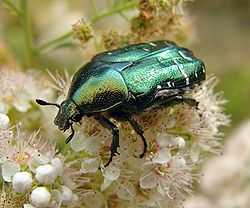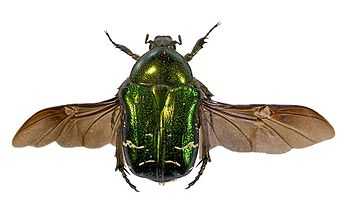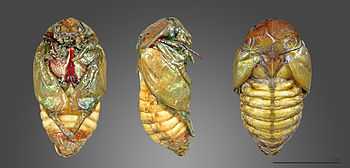Cetonia aurata
| Cetonia aurata | |
|---|---|
 | |
| Scientific classification | |
| Kingdom: | Animalia |
| Phylum: | Arthropoda |
| Class: | Insecta |
| Order: | Coleoptera |
| Family: | Scarabaeidae |
| Subfamily: | Cetoniinae |
| Genus: | Cetonia |
| Species: | C. aurata |
| Binomial name | |
| Cetonia aurata (Linnaeus, 1758) | |
Cetonia aurata, called the rose chafer or, sometimes, the green rose chafer or goldsmith beetle, is a beetle, 20 mm (¾ in) long, that has a metallic green colouration and a distinct V-shaped scutellum.
The scutellum is the small V-shaped area between the wing cases; it may show several small, irregular, white lines and marks.
The underside of the beetle has a coppery colour, and its upper side is sometimes bronze, copper, violet, blue/black, or grey.
Cetonia aurata should not be confused with the North American rose chafer, Macrodactylus subspinosus.
The rarely seen noble chafer is very similar to the rose chafer. One way to identify it is to look at its scutellum; on the noble chafer the scutellum is an equilateral triangle, but on the rose chafer it is an isosceles triangle.
Overview
Rose chafers are capable of very fast flight; they fly with their wing cases down. They pull their feet inside their legs and can push them out, if needed.
They feed on pollen, nectar, and flowers, especially roses. They can be found among roses on warm sunny days from May until June or July, and occasionally as late as September.
Rose chafers are found in southern and central Europe and in the southern part of the United Kingdom, where they sometimes seem to be very localized. They are a very beneficial saprophagous species (detritivores). Their larvae are the insect equivalent of earthworms.
Larvae
The larvae are C–shaped and have
- a firm, wrinkled, hairy body,
- a very small head,
- and tiny legs.
The larvae overwinter wherever they have been feeding, which may be in compost, manure, leaf mould, or rotting wood. They grow very quickly and will have moulted twice before the end of autumn. They have a two-year life cycle.
They pupate in June or July. Some adult beetles may emerge in autumn, but the main emergence is in spring, when the beetles mate.
After mating, the female beetles lay their eggs in decaying organic matter and then die.
Origin of its color
The metallic green coloring of the beetle is caused by the reflection of mostly circularly polarised light, typically left circularly polarised light. When viewed through a right circular polariser, the beetle appears to be colorless.[1]
Many species of scarab beetles (scarabaeidae) are known to emit typically left circularly polarised light. (See Circular polarisation in nature.)
In analytical psychology

In his book Synchronicity: An Acausal Connecting Principle, Swiss psychologist C. G. Jung tells this story, starring a Cetonia aurata, as an example of a synchronistic event:
My example concerns a young woman patient who, in spite of efforts made on both sides, proved to be psychologically inaccessible. The difficulty lay in the fact that she always knew better about everything. Her excellent education had provided her with a weapon ideally suited to this purpose, namely a highly polished Cartesian rationalism with an impeccably “geometrical” idea of reality. After several fruitless attempts to sweeten her rationalism with a somewhat more human understanding, I had to confine myself to the hope that something unexpected and irrational would turn up, something that would burst the intellectual retort into which she had sealed herself. Well, I was sitting opposite her one day, with my back to the window, listening to her flow of rhetoric. She had had an impressive dream the night before, in which someone had given her a golden scarab — a costly piece of jewellery. While she was still telling me this dream, I heard something behind me gently tapping on the window. I turned round and saw that it was a fairly large flying insect that was knocking against the window-pane from outside in the obvious effort to get into the dark room. This seemed to me very strange. I opened the window immediately and caught the insect in the air as it flew in. It was a scarabaeid beetle, or common rose-chafer (Cetonia aurata), whose gold-green colour most nearly resembles that of a golden scarab. I handed the beetle to my patient with the words, “Here is your scarab.” This experience punctured the desired hole in her rationalism and broke the ice of her intellectual resistance. The treatment could now be continued with satisfactory results.[2]
In a separate account of the incident in the same book, Jung wrote, “I must admit that nothing like it ever happened to me before or since, and that the dream of the patient has remained unique in my experience.”[3]
Gallery
-

Larva
-

Pupa
-
.jpg)
Side view
-

Close-up
-

The flight pattern of a rose chafer
See also
- Scarab (a disambiguation page)
- Scarab (artifact)
- Synchronicity
References
- ↑ Hegedüsa, Ramón; Győző Szélb and Gábor Horváth (September 2006). "Imaging polarimetry of the circularly polarizing cuticle of scarab beetles (Coleoptera: Rutelidae, Cetoniidae)". Vision Research 46 (17): 2786–2797. doi:10.1016/j.visres.2006.02.007. PMID 16564066. Retrieved 2009-05-26.
- ↑ Jung, C.G. (1969). Synchronicity: An Acausal Connecting Principle. Princeton, New Jersey: Princeton University Press. pp. 109–110. ISBN 978-0-691-15050-5.
- ↑ Jung, C.G. (1969). Synchronicity: An Acausal Connecting Principle. Princeton, New Jersey: Princeton University Press. p. 22. ISBN 978-0-691-15050-5.
External links
| Wikispecies has information related to: Rose chafer |
| Wikimedia Commons has media related to Cetonia aurata. |
- La Cétoine Dorée (Cetonia aurata) (Coléoptère Cetoniidae)
- Photos of Cetonia aurata
- Photos of Rose chafer - Cetonia aurata and other flower beetles.
- Rose chafer Cetonia aurata, some life cycle photos.
- Color of Cetonia aurata through 3D movie glasses, a 24 sec YouTube video demonstrating the handedness of the shiny color of the beetle.